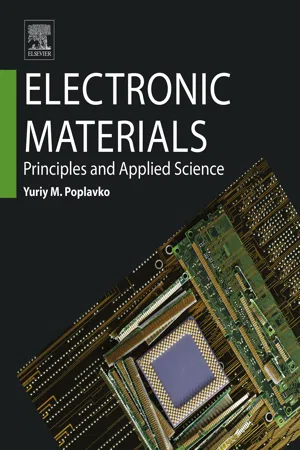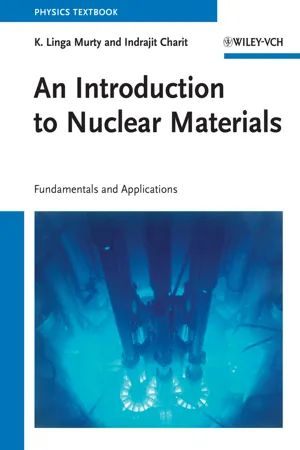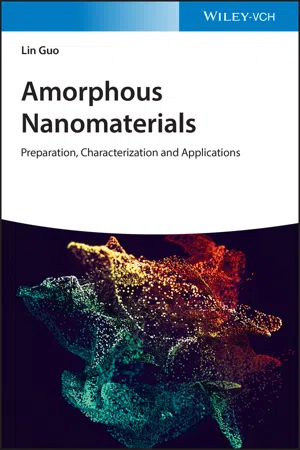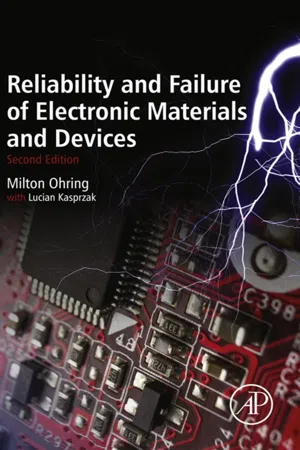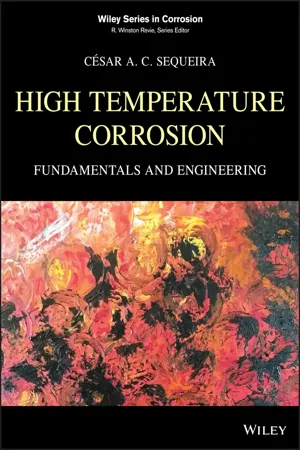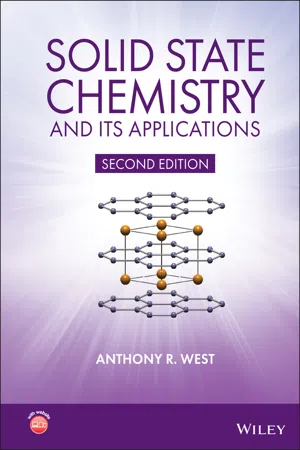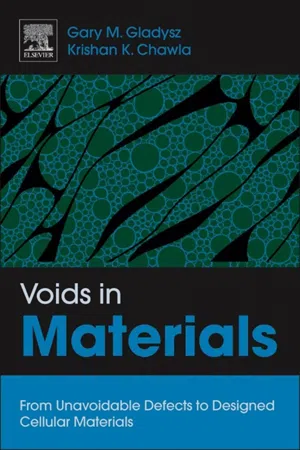Physics
Interstitial Defect
An interstitial defect in a crystal lattice occurs when an extra atom occupies an interstitial site between the regular lattice atoms. This disrupts the regular pattern of the lattice and can affect the material's properties, such as its electrical conductivity and mechanical strength. Interstitial defects are important in understanding the behavior of materials in various applications, including in semiconductor devices and metal alloys.
Written by Perlego with AI-assistance
Related key terms
Related key terms
1 of 4
Related key terms
1 of 3
12 Key excerpts on "Interstitial Defect"
- eBook - ePub
Solid State Physics
From the Material Properties of Solids to Nanotechnologies
- David Schmool(Author)
- 2016(Publication Date)
- Mercury Learning and Information(Publisher)
Atoms can also sometimes position themselves in the spaces between regular lattice points and are called interstitial sites. This could be either the atoms normally in the crystal (self-interstitial) or impurity atoms (impurity-interstitial). In any case, these interstitial atoms can cause some local stresses in the lattice. Smaller atoms can occupy interstitial sites with little or no distortion to the crystal lattice. In Figure 4.1. we show a schematic view of this and other point defects. More complex point defects consist of combinations of vacancies, substitutions and interstitials. One such combination can be generated by moving an atom from its regular lattice position to an interstitial site. Such a combined imperfection in a crystal lattice is called a Frenkel defect. This type of disorder can occur in thermal equilibrium and can be generated by bombardment, such as radiation damage. A similar type of disorder is called the Schottky defect, which occurs in ionic crystals, where the ions of both types (cation and anion) migrate to the crystal surface leaving a vacancy on both ionic sites and thus maintains charge neutrality of the crystal. We note that the vacancies can be separated in the crystal. These defects are illustrated in Figure 4.2. Crystals which are polyatomic should have exact proportions to their components, such as NaCl, Fe 2 O 3 etc. This is referred to as stoichiometry or chemical stoichiometry. Antisite defects can occur in which atoms of one type are located in the position of the other component, such defects are illustrated in Figure 4.1(g) and (h). Preferential vacancies can lead to off-stoichiometry in a crystal and can have an effect on the resulting physical properties of the solid if present in significant proportions. Any disorder in the regular structure of compound solids can give rise to antistructure, where the components swap lattice positions, while maintaining stoichiometry - eBook - ePub
Electronic Materials
Principles and Applied Science
- Yuriy M. Poplavko(Author)
- 2018(Publication Date)
- Elsevier(Publisher)
impurities in a form of sectors and areas of growth. Three-dimensional defects reduce crystal flexibility, affect its elasticity, and strength as well as change the electrical, optical, and magnetic properties of a crystal. Fig. I.2 in the Introduction schematically shows 3D structural defects in polycrystalline materials. Inside of each crystallite, many interplanar structural defects can be observed.Thus 3D defects are solid interstices, liquid or gaseous phases in a crystal, clusters, and other complications with a macroscopic structure. In materials used in electronic technology, 3D defects might also have a fundamental nature, but this case is not considered here.As a result, some conclusions follow:- • Part of atoms (or ions) of a crystal may be absent in their positions that correspond to the ideal crystal lattice scheme. These defects are vacancies. Foreign (impurity) atoms or ions, replacing basic particles that form a crystal, or inserted between them, can also be seen in crystals. Point defects in a crystal can also be its own atoms or ions that are shifted from their normal positions (internode atoms and ions),
- • In the process of crystal growth, as well as during its plastic deformation and in many other cases, dislocations arise. Dislocations are places with ordered accumulation of impurities. The distribution and behavior of dislocations under external influences determine many important mechanical properties of a crystal, including strength, ductility, and other aspects. In particular, the mobility of dislocation determines the plasticity of crystals; dislocations also cause the appearance of internal stress and fracture of crystals. The problem of plastic (i.e., irreversible) flow of metals can be solved by the prevention of dislocation movements. Dislocations impede the process of magnetization and electrical polarization because of their interaction with domain boundaries movement.
- eBook - ePub
An Introduction to Nuclear Materials
Fundamentals and Applications
- K. Linga Murty, Indrajit Charit(Authors)
- 2013(Publication Date)
- Wiley-VCH(Publisher)
photons (mainly because of the relationship between their frequency expressions). Electrons can jump to higher orbits creating electron holes. This can also affect electronic properties (recall the semiconductor theories). However, electronic properties are not of pressing importance in the context of nuclear reactor materials. Henceforth, in this section, our focus would be to give the readers an introduction to various types of crystal defects like point defects (vacancies, self-interstitials, substitutional, or interstitial impurity atoms), line defects (dislocations), surface defects (grain boundaries), and volume defects (voids, cavities, and precipitates).2.2.1 Point Defects
2.2.1.1 Point Defects in Metals/Alloys
Point (or zero-dimensional) defects are associated with imperfections involving an atom or only a few atoms in a localized region. They are often described as “zero-dimensional” defects. There are many types of point defects that one should be aware of. They are schematically shown in Figure 2.25 :Figure 2.25 Various point defects schematically shown on a 2D crystal lattice (1 – monovacancy, 2 – self-interstitial, 3 – interstitial impurity atom, 4 – undersize substitutional atom, and 5 – oversize substitutional atom).Vacancies
Vacancy is simply a vacant lattice site. Vacancies are present in all crystalline solids, pure or impure, under almost all conditions, predictable by the laws of thermodynamics. Vacancies were first imagined to explain the diffusion phenomenon in solids (see Section 2.3). Here we develop a derivation for calculating the equilibrium vacancy concentration. A basic knowledge of thermodynamics is required to understand this approach. We assume that the process of vacancy formation must obey dG - eBook - ePub
- Alan Owens(Author)
- 2019(Publication Date)
- CRC Press(Publisher)
14 in a compound semiconductor must necessarily result in defects – a surplus of atoms of whatever kind will be incorporated into the lattice as point defects, agglomerates or precipitates. The large thermal gradients encountered during the growth process invariably lead to mechanical stress, which gives rise to dislocations. In addition, most compounds are mechanically soft, which means that relatively small stresses are sufficient to cause plastic deformation, even at low temperatures, again giving rise to dislocations.3.5.2 Point DefectsPoint defects are localized defects of atomic dimensions. They are the smallest structural elements, or imperfections, to cause a departure from a perfect lattice structure. They include self-interstitial atoms, interstitial impurity atoms, substitutional atoms and vacancies. In addition, to these “physical” structural point defects, electronic defects are simultaneously formed, which reflect errors in the charge distribution caused by inexact stoichiometry. They are mainly prevalent in ionic crystals and are free to move under the influence of an electric field.The various types of structural point defects are listed in Table 3.2 and illustrated in Fig. 3.14 . A self-interstitial atom is an extra atom that has found its way into an interstitial void in the crystal structure. The creation of a self-interstitial causes substantial distortions in the surrounding lattice and costs more energy than the creation of a vacancy (Q i > Q v ). Consequently, under equilibrium conditions, self-interstitials are present in much lower concentrations than vacancies are. Interstitial impurity atoms, on the other hand, are much smaller than the bulk matrix atoms and fit into the open spaces between the host atoms of the lattice structure.FIGURE 3.14 Schematic illustrating the different types of point defect in a crystalline material. These are (a) self-interstitial atom, (b) substitutional impurity atom, (c) Schottky defect, (d) Frenkel defect and (e) interstitial impurity atom.A substitutional atom is an atom of a different type from the bulk atoms that has replaced a host atom in the lattice. Substitutional atoms are usually close in size (within approximately 15%) to the bulk atoms; otherwise, a solid solution will not form. If the substitutional atoms are much smaller the host atoms, they will be incorporated into the lattice interstitially. If much larger, physically they will mechanically disrupt the lattice and a new phase will form. It should also be noted that for appreciable solid solubility to take place, the crystal structures of both types of atoms must be the same (see Section 3.3 - eBook - ePub
Amorphous Nanomaterials
Preparation, Characterization and Applications
- Lin Guo(Author)
- 2021(Publication Date)
- Wiley-VCH(Publisher)
3 Defect Characterization of Amorphous Nanomaterials 3.1 Introduction Under ideal conditions, atoms in crystalline materials are arranged periodically by rules in three-dimensional (3D) space. However, during the growth process of crystals, it is not possible for a large number of structural units (atoms, molecules, or ion groups) to be arranged in an unmistakable way into a perfect crystal [ 1 – 3 ]. Defects have a significant impact on various properties of materials, and thus, scientists are now using them to design materials with specific properties [ 4 – 7 ]. In solid-state physics, the precise definition of defects is as follows: the collective basic excitation corresponds to an ordered structure of nonlocal disturbances. If ordered structures suffered severe damage, even with a singularity, the order parameter with the singularity area corresponds to defects. The common defects in condensed matter physics include crystal defect vacancy, interstitial midpoint, dislocation line defects, surface defect interface, and twin crystal [ 8, 9 ]. Of note, defects in solid materials are one of the key factors that control and determine the properties of materials. The study of solid defects is also an important branch of solid physics and materials science. However, the role and connection of defects in physics are not easy to be recognized. Until recently, the physical theory of defects in crystalline solid materials was established, including the theory of crystal defects, defect topology, the soliton theory, etc. [ 10 – 12 ] The problem of defects is a nonlinear physical problem, and its complete description must use the nonlinear equations. It is much more difficult to give a statistical description of such nonlinear excitations than linear elementary excitations. Krumhansl and Schneiffer proposed the soliton dynamic domain boundary model and developed a preliminary theory of defect statistics - eBook - ePub
- Serge Bouffard, Nathalie Moncoffre(Authors)
- 2023(Publication Date)
- Wiley-ISTE(Publisher)
-5 . The mechanical stress of a material can also cause defects such as dislocations. However, under irradiation, a wider range of topological defects is generated for those existing at thermodynamic equilibrium, in atomic fractions of higher orders of magnitude.Some examples of defects: a) Frenkel pair: vacancy and interstitial on the same sublattice, b) Schottky defect: an anionic vacancy associated with a cationic vacancy, c) an anti-site defect and an impurity in substitution, d) dislocation vacancy loop and e) macle.Figure 1.5.Moreover, in metallic materials, the defects formed are electrically neutral and the concentrations of vacancies and interstitials can therefore be different. On the other hand, in semi-conductors and insulators, electrical neutrality must be ensured locally, so that the formation of a single vacancy will be accompanied by a local redistribution of electrical charges. Depending on its environment, this vacancy may have a different charge, which is likely to modify its properties.If the term “defect” with a negative connotation is used, it is in reference to a perfect crystalline order that is repeating itself in all directions to infinity (at least to the limits of the crystal). In reality, disorder governs many properties and improves a number of them:– Electrical properties: the entire operation of microelectronics is based on the doping of silicon. The introduction of very small quantities of electron donor elements (P, As, Sb, etc.) or receivers (B, Ga, In, etc.) radically changes the electrical conductivity, as well as the transport mechanism, by electrons or by holes. - Milton Ohring, Lucian Kasprzak(Authors)
- 2014(Publication Date)
- Academic Press(Publisher)
processing defects, introduced during various steps of the manufacturing sequence. These are grosser in scale than lattice defects and strongly influence yield and malfunction of devices. Returning to lattice defects, the rationale for studying them is to intelligently assess their potential and actual roles as root causes of failures, even though it may be difficult to draw causal relationships.Table 3.1 Imperfections in condensed matterClassification Definition Examples Vibrating atom Temporary, small displacement from ideal position Zero point, thermal Electronic charge Charge carrier excited from ground-state bonding configuration Electron (− ), hole (+), exciton Chemical impurity Foreign atom of differing size, valence, electronegativity, and/or structure relative to host atoms/structure Substitutional, interstitial Point lattice defect Missing host atom, extra host atom, atom occupying wrong lattice site Lattice vacancy, self-interstitial, antisite defect (compounds) Nonbridging bond (Noncrystalline materials) One-dimensional defect Row of atoms at the edge of extra half-plane of atoms Dislocation (edge and screw) Two-dimensional defect Boundary separating an error in stacking sequence of atomic planes, boundary between two crystals of different relative orientation Stacking fault, GB Three-dimensional defect Macroscopic region of different density, chemical content, coordination, etc., from host Void, free volume for glasses, disorder, defect cluster, precipitate From Ref. [2] .3.2.2. Point Defects
The vacancy or absence of an atom at a lattice site is the most basic defect. Vacancies occur in all classes of solids. Not surprisingly, because the movement of atoms from one location to another (diffusion) requires vacancies, and because diffusion is easier at higher temperature, we find that the fraction or concentration of vacant lattice sites (C v- eBook - ePub
- Derek Hull, D. J. Bacon(Authors)
- 2011(Publication Date)
- Butterworth-Heinemann(Publisher)
In a pure metal two types of point defect are possible, namely a vacant atomic site or vacancy, and a self-interstitial atom. These intrinsic defects are illustrated for a simple cubic structure in Fig. 1.10. The vacancy has been formed by the removal of an atom from an atomic site (labeled v) and the interstitial by the introduction of an atom into a non-lattice site at a,, 0 position (labeled i). It is known that vacancies and interstitials can be produced in materials by plastic deformation and high-energy particle irradiation. The latter process is particularly important in materials in nuclear reactor installations. Furthermore, intrinsic point defects are introduced into crystals simply by virtue of temperature, for at all temperatures above 0 K there is a thermodynamically stable concentration. The change in Helmholtz free energy Δ F associated with the introduction of n vacancies or self-interstitials in the crystal is Figure 1.10 (a) Vacancy, (b) self-interstitial atom in an (001) plane of a simple cubic crystal. (1.2) where E f is the energy of formation of one defect and Δ S is the change in the entropy of the crystal. nE f represents a considerable positive energy, but this is offset by an increase in the configurational entropy due to the presence of the defects. The equilibrium concentration of defects, given by the ratio of the number of defects to the number of atomic sites, corresponding to the condition of minimum free energy is approximately (1.3) where k is Boltzmann’s constant and T is the temperature (in deg K). For the vacancy, the formation energy,, is that required to remove one atom from its lattice site to a place on the surface of the crystal. Experimental values fall in the range ∼1–3 eV, i.e. 0.16–0.48 aJ. They scale with the melting temperature, T m, and an approximate rule is. Thus for copper, for which T m =1356 K and, the fraction of atom sites vacant at 1300 K is ∼10 −5 and at 300 K is ∼10 −22 - eBook - ePub
High Temperature Corrosion
Fundamentals and Engineering
- César A. C. Sequeira(Author)
- 2018(Publication Date)
- Wiley(Publisher)
plane defects comprise stacking faults, internal surfaces (e.g. grain boundaries), and external surfaces.In addition to the structural defects, crystals also contain electronic imperfections, i.e. electrons and holes, that are relatively free to move in the crystal.The different types of imperfections and deviations from the ideal structure and composition determine a number of properties of solids. For instance, it is now well established that diffusion in solids takes place because of the presence of imperfections. Point defects are responsible for lattice diffusion; dislocation or short circuit diffusion takes place along the line defects, and grain boundary and surface diffusion along the plane defects. Solid‐state diffusion, in turn, determines or strongly influences a number of properties or processes in solids such as mass transport in solids, solid‐state reactions, sintering, many precipitation reactions, high‐temperature creep, gas–metal reactions resulting in the formation of compact layers of reaction products, etc. Electronic imperfections determine such properties as electronic conductivity, thermoelectric power, electro‐optical properties, etc.The crystal structures of many of the simple metallic oxides to be discussed later can be considered to consist of a hexagonal or cubic close‐packed oxygen ions, while the metal ions occupy interstitial voids in the close‐packed structures. The interstitial voids in close‐packed structures are of two types:- Voids surrounded by four oxygen ions, the so‐called tetrahedral voids.
- Voids surrounded by six oxygen ions, the octahedral voids.
In the close‐packed structure, there are two tetrahedral sites and one octahedral site per oxygen ion. In different crystal structures of simple metal oxides, the cations often occupy the tetrahedral and/or octahedral interstices in regular patterns (Wells 1950 ; Azaroff 1960 ; Naray‐Szabo 1969 - eBook - ePub
- Anthony R. West(Author)
- 2022(Publication Date)
- Wiley(Publisher)
Recent research shows, however, that interstitial atoms do perturb the host structure in the immediate vicinity of the interstitial atom. An example is shown in Fig. 2.7 for Pt metal containing an interstitial Pt atom. Instead of the interstitial Pt occupying the octahedral site, it is displaced by about 1 Å off the centre of this site and in the direction of one of the face centre atoms. The Pt on this face centre also suffers a corresponding displacement in the same [100] direction. Thus, the defect involves two atoms, both of which are on distorted interstitial sites. This defect complex is known as a split interstitial or dumb‐bell‐shaped interstitial. A similar split Interstitial Defect is present in bcc metals such as α ‐Fe. The ‘ideal’ site for the interstitial would be in the centre of a cube face, but instead it is displaced off the centre of this site in the direction of one of the corners. At the same time, an adjacent corner atom is displaced in the same [110] direction, i.e. along a face diagonal, Fig. 2.8. The exact structure of Interstitial Defects in alkali halides is not clear. Although Schottky defects predominate, interstitials are also present but in much smaller quantities. Calculations indicate that, in some materials, occupation of undistorted interstitial sites is favoured whereas in others a split interstitial is preferred. The presence of vacancies in both metals and ionic crystals causes a relaxation of the structure in the immediate environment of the vacancy. In metals, the atoms surrounding the vacancy relax inwards by a few percent, i.e. the vacancy becomes smaller, whereas in ionic crystals the reverse occurs and as a result of an imbalance in electrostatic forces the atoms relax outwards. Figure 2.7 Split Interstitial Defect in an fcc metal. Figure 2.8 Split interstitial in a bcc metal, e.g. α‐Fe. Symbols as in Fig - eBook - ePub
Voids in Materials
From Unavoidable Defects to Designed Cellular Materials
- Gary M. Gladysz, Krishan K. Chawla(Authors)
- 2014(Publication Date)
- Elsevier(Publisher)
(2.2) . The numerator in this density calculation is the summation of the number of each atom in a unit cell multiplied by its corresponding relative atomic mass. The denominator is the volume of the unit cell multiplied by Avogadro’s number.whereρ =∑i = 1y( n A )iV N(2.2)n = number of “i ” atoms/ions per unit celli = identity of element in the unit celly = number of distinct elements in the unit cellA = relative atomic mass, g/molV = volume of the unit cell, cm3N = Avogadro’s number (6.023 × 1023 /mol)2.2.2. Defects and Real Properties
In inorganic chemistry, it is axiomatic to say “the perfect solid does not exist in nature and its reactive properties are determined, to a great extent, by the defects present in its structure.” As mentioned in Chapter 1 , the focus of this book is the characterization and functionality of voids in materials, regardless of their size or shape. As the quote above infers, physical and chemical properties are not solely determined simply by the chemical structure of the solid. Many of their properties are derived from the voids and empty spaces present in the material.As such, intrinsic point defects in crystalline materials are of interest because they impart interesting and diverse functionality to materials. Some of these properties are color centers or F-centers, diffusion, and semiconducting properties. Point defects can also diffuse, agglomerate, and their amount or concentrations can be measured and to a certain extent, controlled.2.2.2.1. Types of Point Defects
We include point defects in our description of voids. They are caused by missing atoms at crystal lattice site. A Schottky defect is a type of vacancy in an ionic crystal where cations and anions are missing from a crystal lattice. We should emphasis that the cations and anions are missing in a stoichiometric ratio in order to maintain the charge neutrality. In metals, which consist of metallic ions distributed in a sea of electrons, a vacancy is simply a missing atom; there is no restriction of charge neutrality.Schottky defects are present in all ionic crystalline materials and thus, are a type of intrinsic void. Vacant sites are present in metals as well. There are several parameters that can influence the amount or concentration of these vacancies, temperature being the major factor. The following expression is used to calculate the number of point defects in thermal equilibrium. - eBook - ePub
- Anthony R. West(Author)
- 2014(Publication Date)
- Wiley(Publisher)
The occurrence of antiphase domains can be seen by dark field imaging in the electron microscope; the boundaries are seen as fringes. If the boundaries are regularly spaced, unusual diffraction effects occur; a superlattice is associated with the ordering of domains but because, at the boundaries, the structure expands due to repulsions between like atoms, satellite spots appear on either side of the supercell positions in the reciprocal lattice. This has been observed in alloys such as CuAu and in minerals such as plagioclase feldspars.2.5 Dislocations and Mechanical Properties of Solids Dislocations are an extremely important class of crystal defect:- They are responsible for the relative weakness of pure metals and in certain cases (after work-hardening) for just the opposite effect of extra hardness.
- The mechanism of crystal growth from either solution or vapour appears to involve dislocations.
- Reactions of solids often occur at active surface sites where dislocations emerge from the crystal.
Dislocations are stoichiometric line defects. Their existence was postulated long before direct experimental evidence for their occurrence was obtained. There were several types of observation which indicated that defects other than point defects must be present in crystals:(a) Metals are generally much softer than expected. Calculations of the shearing stress of metals gave values of ∼106 psi whereas experimental values for many metals are as low as ∼102 psi. This indicated that there must be some kind of weak link in their structures which allows metals to cleave so easily.(b) Many well-formed crystals were seen under the microscope, or even with the naked eye, to have spirals on their surfaces which clearly provided a mechanism for crystal growth. Such spirals could not occur in perfect crystals, however.(c)
Index pages curate the most relevant extracts from our library of academic textbooks. They’ve been created using an in-house natural language model (NLM), each adding context and meaning to key research topics.
Explore more topic indexes
Explore more topic indexes
1 of 6
Explore more topic indexes
1 of 4

